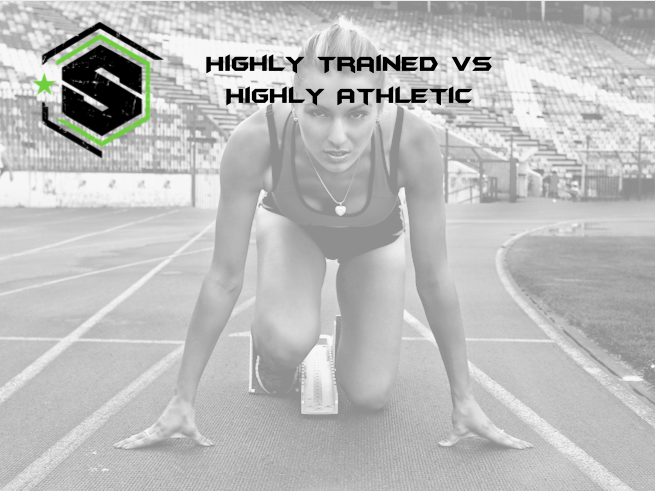Highly Trained vs. High Athletic
Whats the difference?
This is a short topic, but an important one. Many people confuse “highly athletic” athletes with “highly trained” athletes. They are not one in the same, and in fact are likely not even correlated.
We all know a highly athletic athlete: they have high motor learning and control, and high motor output ability. They usually have an easy time with skill acquisition and retention, have great test results on markers of performance (10 yard, 20 yard, pro agility etc) with little to no prior training. Most team professional athletes would fall into this category. Team sports have long competitive seasons; they do not have enough training cycles, nor are the actual training offseasons long enough, to inhibit an athlete’s adaptive ability to lower intensity training.
A highly trained athlete is defined completely differently, however. They are neither defined as an elite athlete, nor a great athlete with elite motor control and quick skill acquisition (though they may have had this or learned this, it is NOT a requirement to being highly trained). An athlete who is highly trained is one that has trained to the point that only using highly intense, focused training means will cause a physiological effect on their performance. Extensive GPP training with this athlete will likely be detrimental to their performance rather than assisting it. They have exhausted the ability for less intense, direct and focused work to cause a physiological adaptation due to their elite training ability and history. Long periods of specific physical preparation are required to improve sporting ability, and thus require highly planned and organized training methods that cater to the very specific goals at hand. The number of programs and modalities that will increase this abilities performance are low, and thus making this athlete better through training is extremely difficult. Most athletes in this area are international level competitors in specific events such as track events, throwing, rowing, weight lifting etc.
When planning and evaluating your training methods, pick a method of intensity that fits the training level of your athlete. A common mistake in many programs is they “train up” to where they want the athlete to be (give an advanced program to an underdeveloped athlete), instead of giving a proper intensity and progression level to actually get the athlete there to the advanced level. Use up easier, less intense resources before moving on to more intense ones when necessary. Another mistake is to see athletic ability and assume a high level of intensity is required to elicit a response. Again, this is an inaccurate assumption, and one that will not benefit the long-term development of the athlete by using high intensity resources early.
Very few of us have ever had the pleasure to work truly “highly trained” athletes. Many of the athletes we see the most, including NFL, MLB, NBA and more, could be classified as low or moderately trained, based solely on their previous training history and the ability for less specific, lower intensity training to increase specific performance. Keeping this in mind can help influence your training protocols with your athletes!


Very interesting points you have observed, appreciate it
for putting up.Blog money
Thank you for your sharing. I am worried that I lack creative ideas. It is your article that makes me full of hope. Thank you. But, I have a question, can you help me?
Thank you for your sharing. I am worried that I lack creative ideas. It is your article that makes me full of hope. Thank you. But, I have a question, can you help me?
Thank you for your sharing. I am worried that I lack creative ideas. It is your article that makes me full of hope. Thank you. But, I have a question, can you help me?
Thanks for sharing. I read many of your blog posts, cool, your blog is very good.
Thank you for your sharing. I am worried that I lack creative ideas. It is your article that makes me full of hope. Thank you. But, I have a question, can you help me?
I don’t think the title of your article matches the content lol. Just kidding, mainly because I had some doubts after reading the article. https://accounts.binance.info/register?ref=P9L9FQKY
I don’t think the title of your article matches the content lol. Just kidding, mainly because I had some doubts after reading the article.
I don’t think the title of your article matches the content lol. Just kidding, mainly because I had some doubts after reading the article.
I don’t think the title of your article matches the content lol. Just kidding, mainly because I had some doubts after reading the article.
Thanks for sharing. I read many of your blog posts, cool, your blog is very good.
Your article helped me a lot, is there any more related content? Thanks!